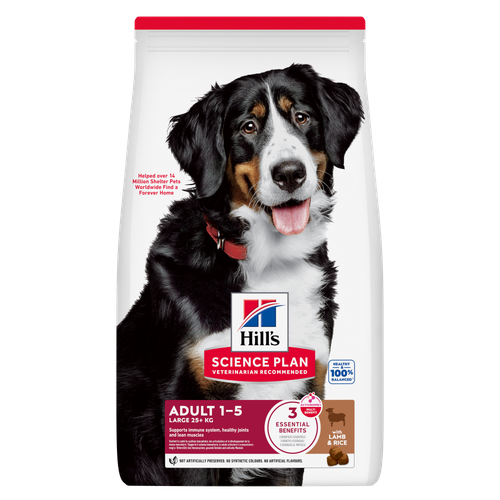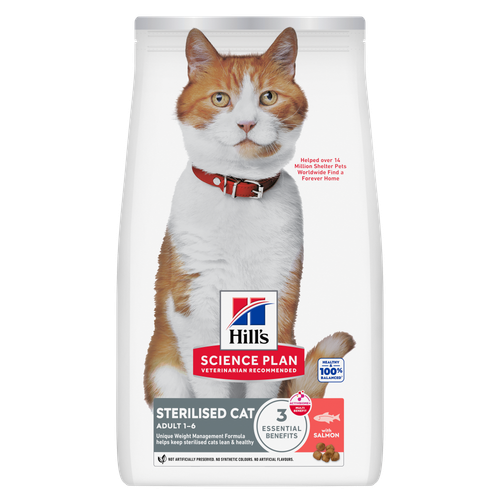
-
Find the right food for your petTake this quiz to see which food may be the best for your furry friend.Find the right food for your petTake this quiz to see which food may be the best for your furry friend.Featured products
 Large Breed Adult Dog Food
Large Breed Adult Dog FoodHill's Science Plan Large Breed Adult Dog Food with Lamb & Rice is a complete pet food, specially formulated with ActivBiome+ Multi-Benefit Technology.
This food is specifically designed to fuel the energy needs of large breed dogs during the prime of their life.Shop Now Adult Light Dog Food
Adult Light Dog FoodHill's Science Plan Light Adult Wet Dog Food is a complete premium pet food for adult dogs that tend to gain weight easily. This deliciously smooth loaf is formulated to deliver the appropriate amount of energy to support weight maintenance in adult dogs.
Shop Now Perfect Digestion Large Breed Puppy Food
Perfect Digestion Large Breed Puppy FoodPrecisely balanced nutrition with Hill's ActivBiome+ prebiotic blend actively contributes to supporting digestive health and overall wellbeing to help your pet feel their best
Shop NowFeatured products Adult Cat Food
Adult Cat FoodHill's Science Plan Adult Cat Food with Chicken is a complete pet food, specially formulated with ActivBiome+ Multi-Benefit Technology.
This food is specially formulated to fuel the energy needs of cats during the prime of their life.Shop Now CULINARY CREATIONS ADULT CAT FOOD
CULINARY CREATIONS ADULT CAT FOODHill's Science Plan CULINARY CREATIONS Adult cat food with Salmon & Carrots was formulated to provide a great-tasting experience to cats. Its delicious flavour and texture are combine with essential nutrients to support cats' optimal health during the prime time of their life. Specially formulated with high-quality salmon protein, essential taurine for heart health & balanced minerals to support kidneys & bladder.
Shop Now Sterilised Adult Cat Food
Sterilised Adult Cat FoodHill's Science Plan Adult Sterilised Cat Dry Food with Salmon is specially formulated with ActivBiome+ Multi-Benefit Technology. It is a precisely balanced nutrition, tailored to meet the needs of sterilised cats, to help keep sthem lean & healthy.
Shop Now -
Dog
- Dog Tips & Articles
-
Health Category
- Weight
- Food & Environmental Sensitivities
- Urinary
- Digestive
- Joint
- Kidney
-
Life Stage
- Puppy Nutrition
- Adult Nutrition
- Senior Nutrition
Cat- Cat Tips & Articles
-
Health Category
- Weight
- Skin & Food Sensitivities
- Urinary
- Digestive
- Kidney
-
Life Stage
- Kitten Nutrition
- Adult Nutrition
Featured articles The Incredible Science Behind Your Pet's Microbiome
The Incredible Science Behind Your Pet's MicrobiomeLearn what your pet's microbiome is, how it contributes to your pet's gut and overall health, and why nutrition is important in maintaining healthy microbiomes.
Read More Pet Nutrition: What Makes "Healthy" Pet Food Healthy? | Hill's Pet
Pet Nutrition: What Makes "Healthy" Pet Food Healthy? | Hill's PetIn people, the right diet is very important. If you are eating the wrong way for your metabolism, activity level, age and lifestyle you could end up with health issues.
Read More Microchipping: The Facts | Hill's Pet
Microchipping: The Facts | Hill's PetThe government has announced that as of April 2016, all dogs in the UK must be microchipped by law.
Read More -


Welcome to Hill’s Doggy Boot Camp! Did you know that exercising with your pet is a great way to keep fit and help keep your dog at their ideal weight? We’re going to show you how to do doggy boot camp with some simple exercises that involve your pet in your fitness routine.
Do the ‘prep’
Fit as a fiddle? Great! If you do have any concerns about your own fitness, or that of your pet, always get a health check before taking vigorous exercise. Dogs that are carrying too much weight, or have joint problems might still be able to exercise but the type of exercise they can do might have to be modified. Always ask your vet if you’re not sure.
You don’t have to be a sporty superstar or miracle dog trainer to take part – doggy boot camp is designed for normal pet dogs and their owners, just like you.
Get warmed up
As with any good exercise class the first step is a warm up to loosen those muscles and prevent strains and sprains. Walking your dog on the lead to the boot camp venue or around the exercise space gets you both off to a great start.
Remember to get into the right mind set. Both you and your dog are about to go on a steep learning curve and the most important thing is to have fun, laugh at your mistakes and don’t set your expectations too high for this first session. Your dog already thinks you’re perfect and if they can please you, they’re going to be pretty happy. Also make sure that you give plenty of praise along the way.
If it’s warm, or you both get really active, make sure that you have breaks to drink some water. If you’re sweating, your dog is likely to be keeping cool by panting and that’s going to make him pretty thirsty.
Take your stations
During doggy boot camp you’ll have the chance to go to exercise stations, each of which will offer a different type of exercise. Give yourself five minutes at each station then move round the circuit. Differing exercises will ensure you stretch and strengthen different muscle groups.
Hula-hounding
Our first exercise uses a simple hula hoop. Start off with the hoop touching the ground. Encourage your dog to step through. It’s okay to use food treats if that’s what really motivates your pet. Just reduce their daily meal to account for those extra calories. A mixture of praise, patting and food treats works even better.
Once your dog is confidently stepping through the hoop, raise it off the ground. You might find it easier to have one person holding the hoop as you encourage your pet through by calling their name from the opposite side. In no time at all he’ll be jumping and stretching those leg muscles.
Think about adding a one word command (like ‘hoop’) every time your pet jumps through – this will help them understand what you want next time.
As your dog has regular breaks, use the hula hoop yourself in the usual way.
Greyhound poles
Place a series of poles on the ground, around 50 cm apart. Now all you have to do is run over the poles alongside your dog. To start with this will be easier with your dog on the lead but as you gain in experience you should be able to do this off-lead, as long as the boot camp is taking place in a safe, secure area.
As well as providing good aerobic exercise as you sprint, the poles encourage your dog to lift his feet up, building flexibility and helping with correct positioning of the feet during exercise.
Five minutes of running backwards and forwards will soon build speed and stamina and your dog will be having a whale of a time!


Tasty Tips
The 6-leg lunge
If you have ever performed a leg lunge you will know it’s all about muscle control and balance. Now it’s time to test your skills to the limit and build leg and hip strength.
Start with a walking lunge, take a big step forward then lower your body down, keeping the lower half of your leading leg at right angles to the ground, with the other leg touching the ground behind. Both knees should be bent and the leading knee should not extend beyond your toes. With your back straight and your ‘core’ stomach muscles pulled in, hold in a stationary position.
Now gently encourage your dog on the lead to weave between your legs. As your dog emerges, stand up and take another big step and lunge again using the opposite leg to lead, again encouraging your dog to walk between your legs.
This can be a difficult one to master until you have perfected the lunge, so you might want to practise that at home. Once your dog gets the idea, weaving through becomes a lot easier, allowing you to concentrate on keeping that back straight and using your core abdominal muscles.
Handy hints
You are half way round now. If your motivation is flagging use these handy hints:
- Make it seem exciting and your dog will follow you! Dust off those acting skills and play the part.
- Teaching a new skill requires patience. But think about how impressed everyone will be by your pet’s newly acquired tricks.
- Keep changing the reward you offer. A favourite toy can encourage your dog to follow a path as well as a food treat.
- Start off slow. There’s plenty of time to speed up once your dog has learnt the technique.
- Make time to allow your dog to make new doggy friends. It’s stimulation for their mind and every bit as important.
- Remember that laughing increases your heart rate by 10-20% and is therefore a justifiable element of your fitness routine.
The Collie Weave
We’ve all seen those agile collies weaving between poles at big events. If you take your time your dog could do it too. Show the way by running alongside your dog who stays on the lead. Help guide him though the poles by leaning and applying gentle pressure with your body and using lots of encouragement. He’ll soon be racing you to the finishing line.
High 5 Plank
You’ll be relieved to know that this move isn’t too complicated.
We’re aiming for an exercise here that is easy to do and to build fitness through holding position and repetition. While you exercise your body this one tests your dog’s mind.
In the plank you aim to lie face-down and then raise your body with your weight resting on your lower arms which are held flat to the floor. The body is held in a straight line putting tension on the core abdominal muscles. Simply holding that pose for a few minutes is a great work out.
As you hold the plank position, see if you can get your dog to go from the stand position to lie down face to face, or even to ‘high five’ you if you raise your hand.
Sit ups and downs
Otherwise known as ‘squats’ by gym bunnies, this exercise is great for toning up. Stand straight with your feet apart and lower your body, pushing your hips back and bending your knees. As you lower into the squat encourage your dog to sit.
Hold in the squatting position then rise to stand again, at the same time instructing your dog to stand too.
As you’re lowering into the squat you might find it easier to stretch your arms out in front of you for balance and you can guide your dog into the correct position at the same time.
Again you just have to repeat this exercise as often as is comfortable while at this exercise station.
Cool down
Once you have completed a whole circuit you might want to go round once more for a complete hour long class.
Then it’s time for some gentle stretches to help you both cool down slowly and get your breath back.
DO
Get a health check if you have any concerns over your own or your pet’s ability to do exercise.
Make sure fresh drinking water is available for both of you
Give other dog owners space to do their own exercises and be aware that some dogs need more personal space than others
Keep your dog on a lead during the exercise when participating in a class with other dogs and their owners
Make sure you are carrying out the exercises properly and seek advice from qualified instructors
Know you and your dog’s limits – if an exercise hurts or isn’t enjoyable move on to something else.
DON’T
Feed your dog in the hour before or after exercise, other than small amounts of treats to reward positive behaviour
Feel frustrated or impatient if you or your dog can’t do an exercise properly. The aim is to have fun and get active rather than to perform at a high level.
Stop after one class! Do doggy boot camp regularly to really benefit.
Did you know that carrying just 20 per cent excess weight can predispose your pet to arthritis, heart disease and diabetes?
If your dog is overweight talk to your veterinary surgeon about a weight loss programme. Hill’s Prescription Diet Metabolic+Mobility is one way forward for pets when weight gain becomes an issue but let’s do all we can to keep them active and at their ideal weight.


One of our staff authors prepared this article for you
Related products

Hill's Science Plan Light Adult Wet Dog Food is a complete premium pet food for adult dogs that tend to gain weight easily. This deliciously smooth loaf is formulated to deliver the appropriate amount of energy to support weight maintenance in adult dogs.

Hill's Science Plan Large Breed Adult Dog Food with Lamb & Rice is a complete pet food, specially formulated with ActivBiome+ Multi-Benefit Technology.
This food is specifically designed to fuel the energy needs of large breed dogs during the prime of their life.

Precisely balanced nutrition with Hill's ActivBiome+ prebiotic blend actively contributes to supporting digestive health and overall wellbeing to help your pet feel their best

Hill's Science Plan Adult Wet Dog Food with Turkey is a complete premium pet food for adult dogs from 1 year. This deliciously smooth minced turkey loaf is formulated to deliver the appropriate amount of energy to support the needs of adult dogs.
Related articles

Learn to see the signs of an upset stomach in your dog, understand the triggers and explore some possible solutions.

Dog obesity is a significant problem - learn more about helping your dog become trimmer and healthier through improved nutrition.
Discover the causes, signs, and treatments of kidney disease in dogs and find methods of supporting your dog's kidney health. Learn more at Hill's Pet.

Gurgling tummies in turmoil are not good news for pets. Owners who have to clean up the unfortunate consequences, digestive problems are one of the rare downsides to owning a pet.

Put your dog on a diet without them knowing
Our low calorie formula helps you control your dog's weight. It's packed with high-quality protein for building lean muscles, and made with purposeful ingredients for a flavourful, nutritious meal. Clinically proven antioxidants, Vitamin C+E, help promote a healthy immune system.
Put your dog on a diet without them knowing
Our low calorie formula helps you control your dog's weight. It's packed with high-quality protein for building lean muscles, and made with purposeful ingredients for a flavourful, nutritious meal. Clinically proven antioxidants, Vitamin C+E, help promote a healthy immune system.

